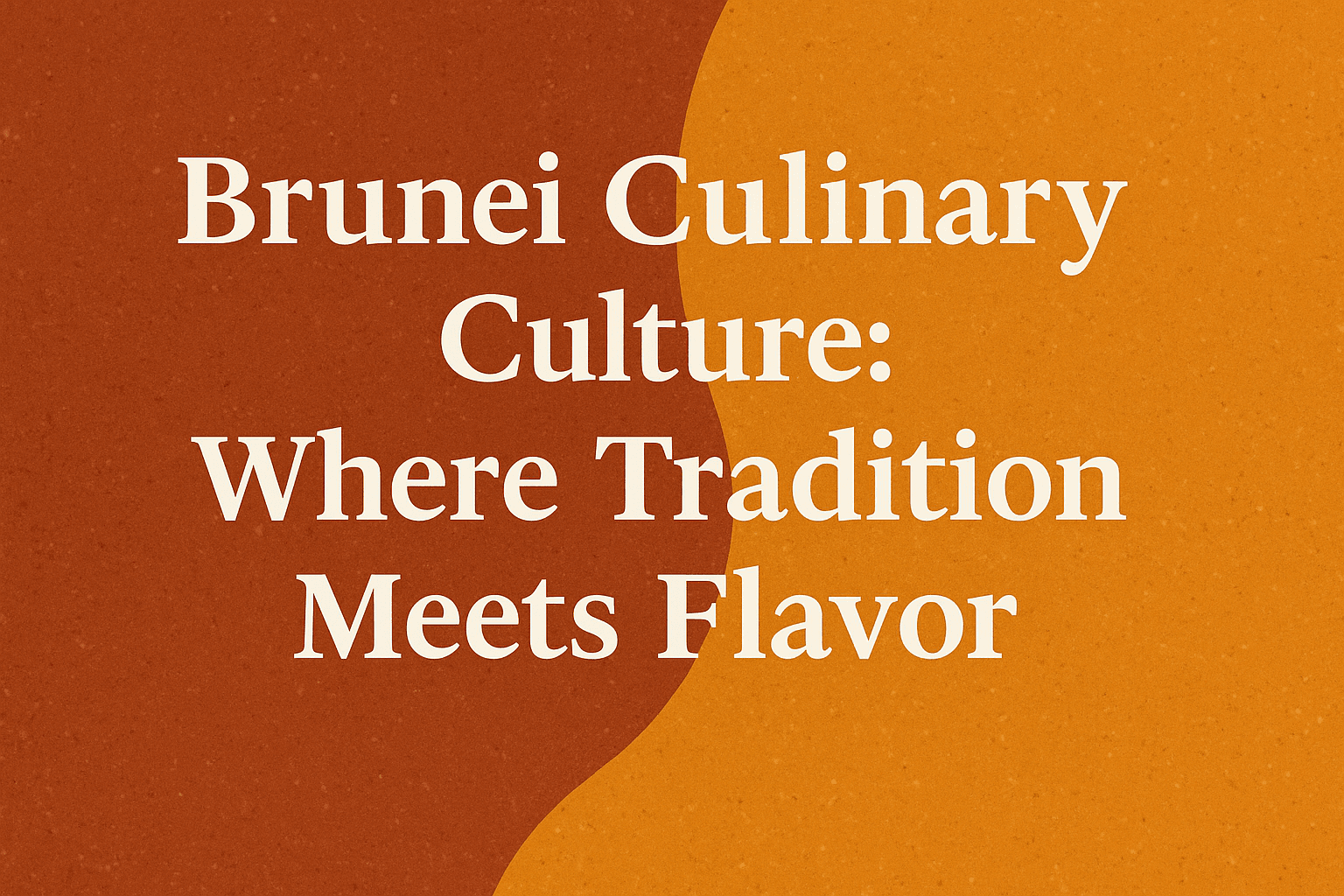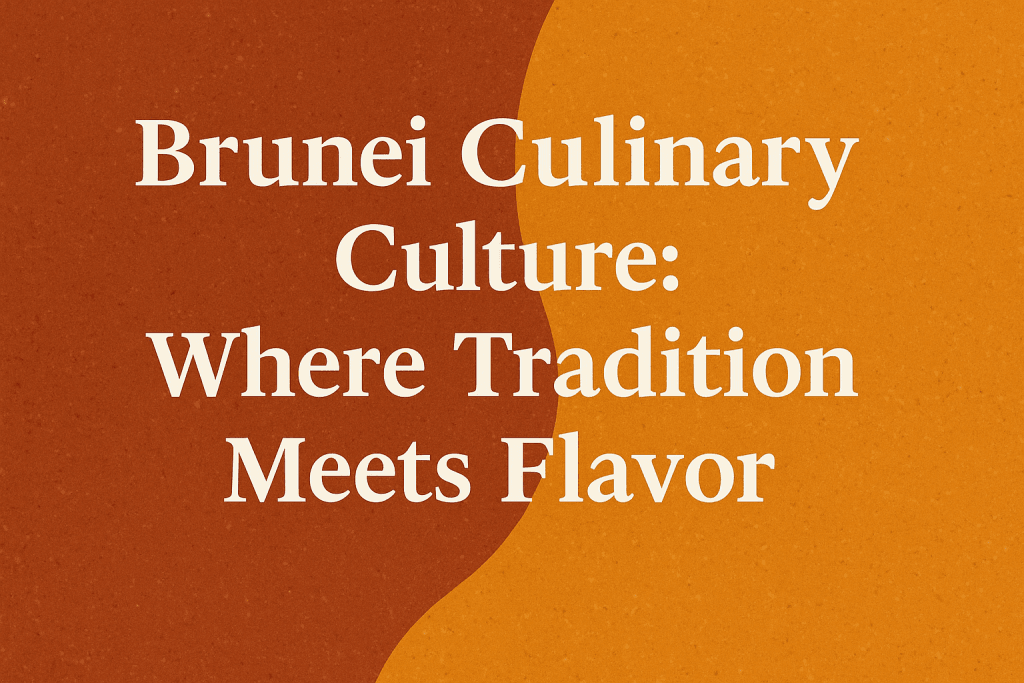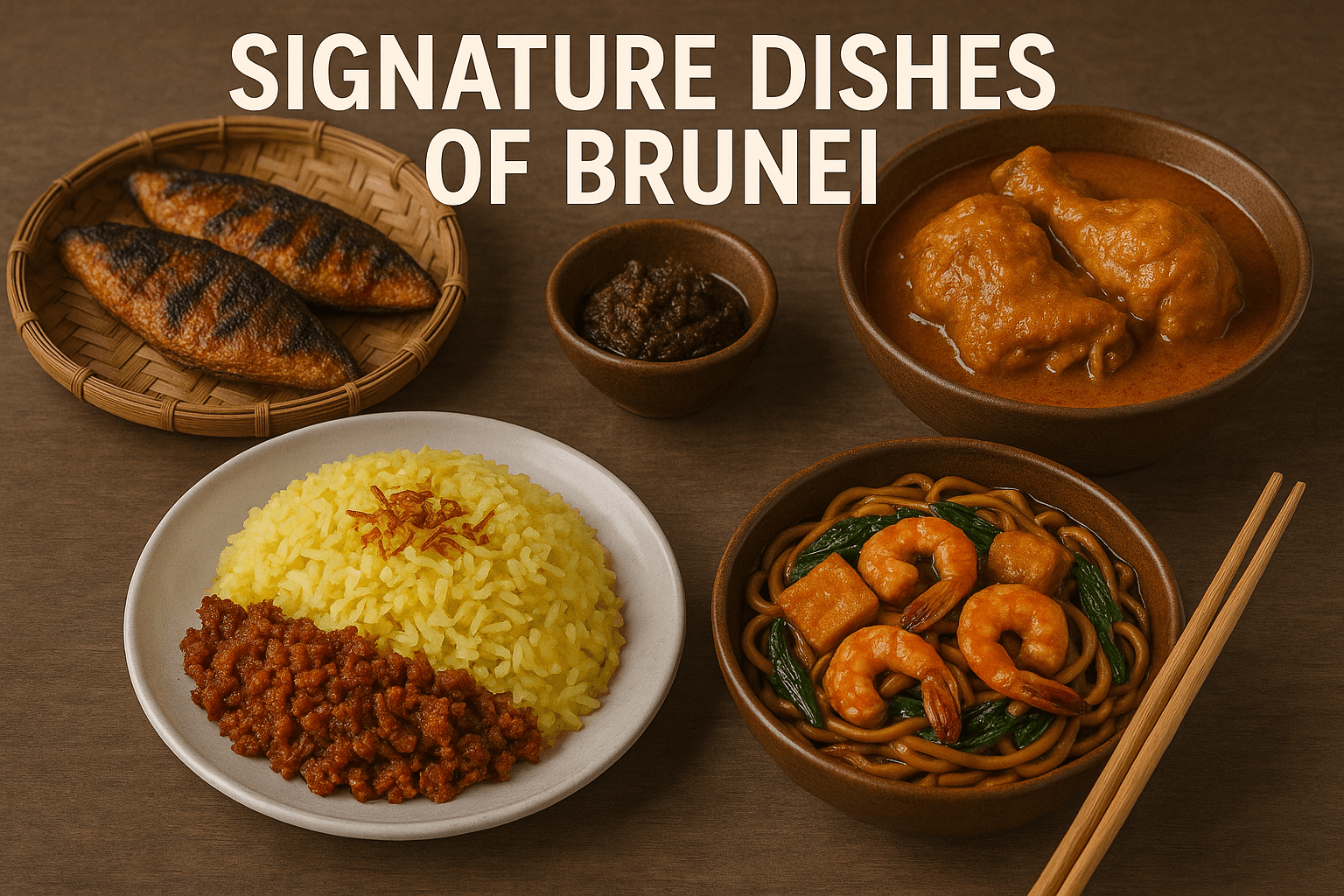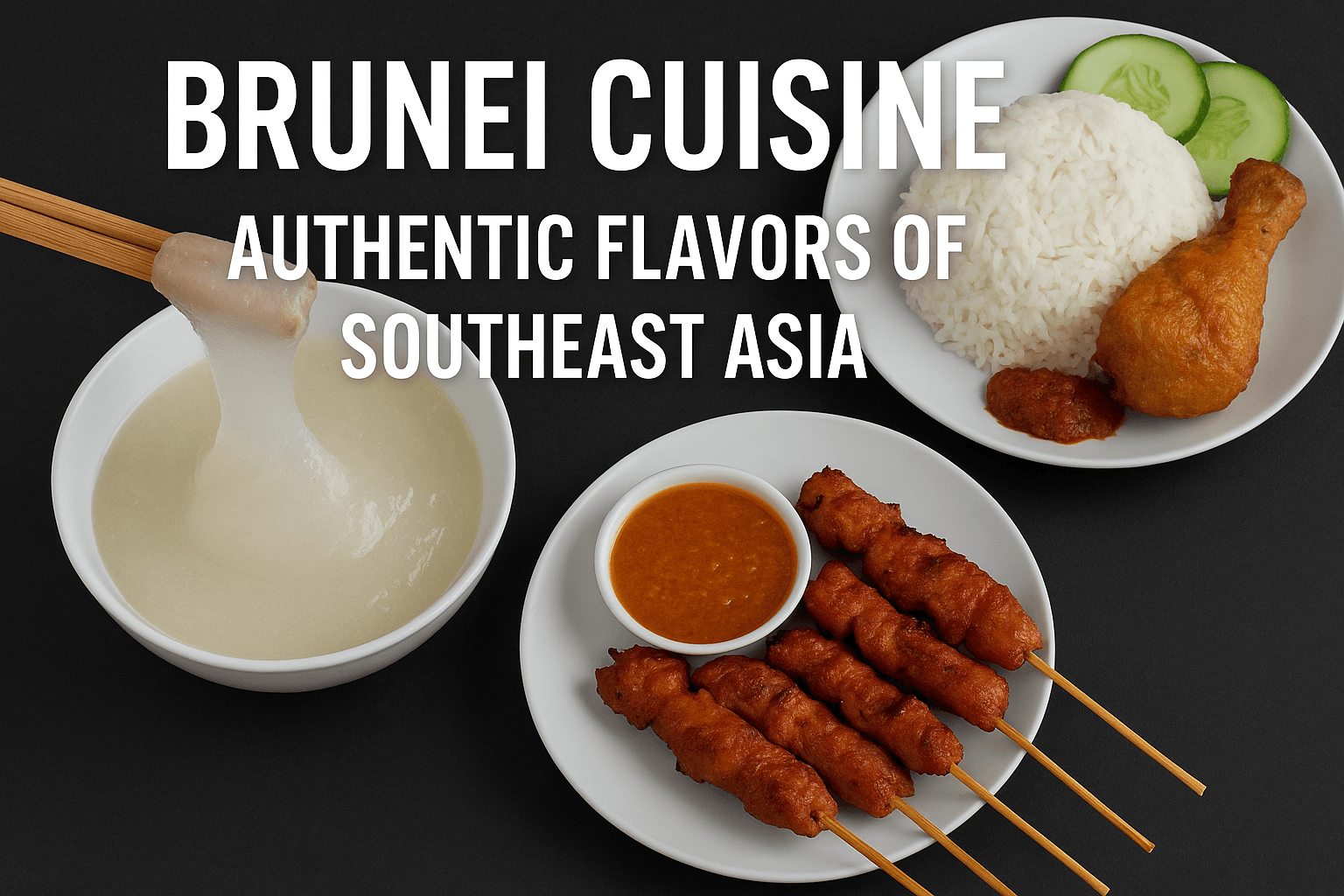Brunei Culinary Culture: Where Tradition Meets Flavor offers an enchanting journey into the heart of a nation where food is not merely sustenance but an expression of identity, heritage, and social connection. Tucked away on the island of Borneo, Brunei Darussalam is often described as a kingdom of unexpected contrasts. Its cuisine is no different—rich in influences yet uniquely rooted in local traditions. For centuries, communities in Brunei have crafted dishes that represent harmony between land and sea, between ancient customs and modern adaptations.
When exploring Brunei Culinary Culture: Where Tradition Meets Flavor, travelers and researchers alike discover how deeply food shapes the Bruneian way of life. From the bustling morning markets to elaborate festive banquets, culinary practices highlight unity, generosity, and a profound respect for natural ingredients. This article will unfold the many layers of Brunei’s gastronomy—its history, traditional dishes, festive customs, preparation methods, street food specialties, religious influences, and its place within Southeast Asian culinary networks.

Historical Roots of Brunei Cuisine
The evolution of Brunei Culinary Culture: Where Tradition Meets Flavor cannot be separated from the region’s history of trade, migration, and cultural exchange. Centuries ago, Brunei was a powerful sultanate with maritime influence stretching across much of Borneo and beyond. This strategic position attracted merchants from China, India, the Middle East, and later, European powers. Along with goods and ideas came food practices that gradually shaped local kitchens.
Indigenous Foundations
Before external influences, indigenous communities thrived on ingredients provided by tropical forests and surrounding waters. Staples included rice, taro, sago, wild vegetables, and an abundance of fish. Techniques such as grilling over open flames, fermenting, and wrapping food in banana leaves remain integral to Brunei’s identity.
Islamic Influence
With the arrival and establishment of Islam in the 14th century, food practices aligned with halal principles. This meant pork was excluded, while beef, chicken, and fish gained prominence. Religious festivals such as Ramadan and Hari Raya added layers of ritual significance to Bruneian dining.
Trade and Regional Crossroads
Chinese merchants introduced noodles, soy-based condiments, and stir-frying methods. Indian traders contributed curries, spices, and breads. Neighboring Malaysia and Indonesia shared coconut-based stews, satay, and sambals. Yet despite such variety, Brunei developed its own culinary distinctiveness, balancing strong flavors with subtle techniques that emphasize freshness.
Staple Ingredients and Flavor Profiles
At the core of Brunei Culinary Culture: Where Tradition Meets Flavor are ingredients that showcase the country’s natural abundance.
Rice: A staple, often steamed or made into nasi katok (simple rice meals).
Sago: Extracted from palm, used for cakes, puddings, and thickening soups.
Coconut: Present in curries, desserts, and beverages.
Seafood: Fish, prawns, and crabs highlight Brunei’s maritime wealth.
Herbs and Spices: Lemongrass, galangal, turmeric, pandan, and chili define aromatic layers.
Banana leaves: Used both as wrapping and to impart subtle earthy fragrance.
The dominant flavor profile is a blend of mild sweetness from coconut, earthy richness from root crops, aromatic freshness from herbs, and balanced heat from chili. Unlike some Southeast Asian cuisines that lean heavily toward spiciness, Brunei’s food tends to be moderate, appealing to both locals and visitors.
Traditional Dishes that Define Brunei
Understanding Brunei Culinary Culture: Where Tradition Meets Flavor requires exploring the country’s signature dishes.
Ambuyat
Perhaps the most iconic national dish, ambuyat is made from sago starch mixed with boiling water until it reaches a sticky, glue-like texture. It is twirled with bamboo sticks and dipped into savory sauces like cacah, often made with shrimp paste, lime, and chili. Ambuyat is communal and symbolic of unity.
Nasi Katok
A simple yet beloved meal consisting of rice, fried chicken, and sambal. Initially a budget option, it has become a staple across Brunei. Its popularity reflects Bruneians’ appreciation for accessible yet flavorful food.
Satay
While common across Southeast Asia, Bruneian satay has a particular sweetness in its marinade, balanced with a spicy peanut sauce. Often enjoyed during festivals and gatherings, it reflects the celebratory nature of the cuisine.
Hati Buyah
Beef lung stir-fried with spices, often served during festive occasions. This dish demonstrates Brunei’s ability to transform less common cuts of meat into delicacies.
Kuih-Muih
A wide variety of sweet cakes and snacks made from rice flour, coconut milk, and palm sugar. Kuih is integral to Bruneian hospitality, offered during tea times and social visits.
Culinary Practices and Social Meaning
Food in Brunei is more than flavor—it is about connection, sharing, and respect. Brunei Culinary Culture: Where Tradition Meets Flavor highlights how mealtimes are a collective affair, emphasizing family and community.
Communal Dining: Meals are traditionally shared, with dishes placed in the center for everyone to enjoy.
Generosity: Hospitality is expressed through abundance; guests are always offered more than they can consume.
Festive Food: During Hari Raya, households prepare elaborate spreads to welcome visitors, symbolizing gratitude and joy.
These practices show how food reflects social cohesion and the nation’s values of harmony and respect.
Street Food and Market Culture
One cannot fully appreciate Brunei Culinary Culture: Where Tradition Meets Flavor without visiting its lively markets. Gadong Night Market in Bandar Seri Begawan is a hub where aromas of grilled meats, fried noodles, and freshly baked kuih fill the air. Popular street foods include:
Roti john (egg sandwich with meat and sauces).
Ayam penyet (smashed fried chicken with sambal).
Pisang goreng (fried banana).
Laksa (spicy noodle soup with coconut base).
Markets are not just about food—they are cultural theatres where traditions, commerce, and modern tastes intersect.
Religious and Ethical Influences
As a Muslim-majority nation, Brunei ensures that all public dining adheres to halal standards. This foundation is crucial to Brunei Culinary Culture: Where Tradition Meets Flavor. Religious practices also affect eating times, such as fasting during Ramadan followed by the iftar meal at sunset. Food is seen not just as pleasure but as part of spiritual discipline and community solidarity.
Influence of Neighbors and Globalization
While rooted in tradition, Brunei’s food scene reflects its connections with the wider world. Malaysian and Indonesian similarities are evident in rendang, sambal, and satay. Chinese restaurants offer noodles and dim sum. Global chains have also entered, but locals maintain loyalty to traditional dishes. The result is a balanced coexistence, enriching Brunei Culinary Culture: Where Tradition Meets Flavor without diluting authenticity.
Culinary Tourism in Brunei
Brunei’s gastronomy is increasingly recognized as a tool for tourism. Culinary festivals, food tours, and cooking demonstrations allow visitors to immerse themselves in Brunei Culinary Culture: Where Tradition Meets Flavor. Tourism boards highlight ambuyat, nasi katok, and festive spreads as must-try experiences. This strategy positions Brunei not only as a natural paradise but also as a cultural dining destination.
Preservation of Culinary Heritage
With globalization, there is a risk of younger generations shifting away from traditional foods. Efforts are underway to safeguard recipes and techniques. Schools, cultural organizations, and family traditions work together to ensure that Brunei Culinary Culture: Where Tradition Meets Flavor remains alive. Documentation of recipes, culinary workshops, and festivals serve as anchors of identity.
Contemporary Adaptations and Innovation
Modern chefs in Brunei experiment with fusion cuisine, blending traditional dishes with global trends. For example, ambuyat may be paired with innovative sauces, or kuih may be presented in contemporary styles. These adaptations keep Brunei Culinary Culture: Where Tradition Meets Flavor relevant, appealing to younger audiences while maintaining authenticity.
Health and Nutrition Aspects
Bruneian food, though rich, also carries health-conscious practices. Ingredients like turmeric, ginger, and fresh herbs are valued for their medicinal properties. Seafood provides lean protein, while tropical fruits such as papaya, pineapple, and rambutan contribute vitamins. Balancing indulgence with natural produce is key to Brunei Culinary Culture: Where Tradition Meets Flavor.
Conclusion
In essence, Brunei Culinary Culture: Where Tradition Meets Flavor is a living narrative of heritage, faith, and creativity. It captures how a small yet vibrant nation expresses its identity through food—an identity built upon generosity, respect, and harmony with nature. From ambuyat’s symbolic unity to nasi katok’s humble popularity, from festive feasts to bustling night markets, Brunei’s cuisine embodies both continuity and change.
Exploring Brunei Culinary Culture: Where Tradition Meets Flavor is more than tasting dishes—it is immersing oneself in the rhythms of community, the echoes of history, and the beauty of tradition blending with flavor. For those seeking an authentic cultural journey, Brunei’s culinary landscape offers one of Southeast Asia’s most rewarding experiences.



